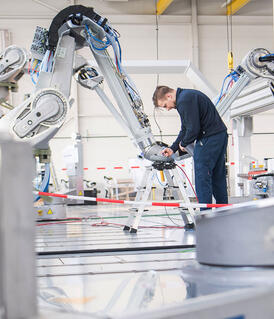The power of SMEs

Germany’s small and medium-sized businesses, known as the “Mittelstand”, are the lifeblood of the country’s economy. Despite the presence of many global players Global players They are the flagships of the economy and global players with an international footing – the major German corporations. The top brands include Daimler, BMW, SAP, Siemens, Volkswagen and Adidas. Shares in the major German companies are listed in the German share index (DAX) at the Frankfurt stock… Read more › and internationally famous major corporations, Germany’s 3.5 million small and medium-sized enterprises ( SMEs SMEs The German economy is characterized first and foremost by small and medium-sized enterprises as well as the self-employed and the independent professions. Some 99.4 percent of all companies are small and medium-sized enterprises. These are firms with annual sales of below EUR 50 million and a… Read more › ), alongside its freelancers and self-employed professionals, are the distinctive feature of the structure of the country’s economy. Over 99% of German businesses are SMEs. These are businesses with an annual turnover below 50 million euros and fewer than 500 employees. Many migrants work in SMEs, and over 800,000 people from migrant backgrounds own their own business, making migrants in Germany a major factor in the economy.
Germany’s SMEs also play a major role on the international stage. Globally there are around 4,000 “hidden champions”, more than 1,700 of which are German SMEs. They provide highly innovative products and solutions, a close relationship with their customers and quick decision-making, thanks to which they are market leaders in Europe and around the world. The creative industry Creative Industry Ingenuity and creativity are an important economic factor for Germany as a business location. Art, film, music, fashion, media, books and lifestyle: The contribution of the creative industry to Germany’s overall economic output is comparable with that of the large industries, namely the automobile… Read more › , which is dominated by SMEs, has established itself in Germany’s economic structure. It is a pioneer as Germany transitions into a digital and knowledge-based economy, and is a significant source of innovations Innovations In 2021, company spending on research and development rose to 75.8 billion Euros. The automotive industry accounts for a large share of these investements. Read more › . There are around 226,000 businesses in the cultural and creative sector, employing more than 1.8 million people in total. The Berlin Berlin Once a year, during the Berlinale film festival, the world of the silver screen focuses its attention on Berlin. And the city’s inhabitants are used to global interest. After all, the people of Berlin have lived in a capital city since 1458. However, there is also a shady side to the city’s history… Read more › - Brandenburg Brandenburg Brandenburg surrounds the capital city of Berlin and benefits from the latter’s “gin and martini belt”. However, with its numerous lakes and forests it also has several trump cards of its own. With the Hohenzollern castles, and in particular Sanssouci Castle, which is included in the UNESCO World… Read more › region is an international hotspot for startups and the creative industries.


